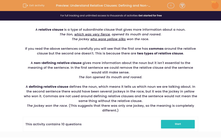A relative clause is a type of subordinate clause that gives more information about a noun.
The lion, which was very fierce, opened its mouth and roared.
The jockey who wore yellow silks won the race.
.jpg)
If you read the above sentences carefully, you will see that the first one has commas around the relative clause but the second one doesn't. This is because there are two types of relative clause.
A non-defining relative clause gives more information about the noun but it isn't essential to the meaning of the sentence. In the first sentence, we could remove the relative clause and the sentence would still make sense.
The lion opened its mouth and roared.
A defining relative clause defines the noun, which means it tells us which noun we are talking about. In the second sentence, there would have been several jockeys in the race, but it was the jockey in yellow who won it. Commas are not used around defining relative clauses, and the sentence would not mean the same thing without the relative clause.
The jockey won the race. (This suggests that there was only one jockey, so the meaning is completely different.)

Are you happy with all that?
If so, let's get started! You can look back to this introduction at any point during the activity by clicking on the red help button on the screen.







